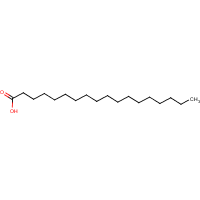Stearic acid
Agent Name
Stearic acid
CAS Number
57-11-4
Formula
C18-H36-O2
Major Category
Other Classes

Synonyms
1-Heptadecanecarboxylic acid; Acidum stearinicul; Century 1240; Cetylacetic acid; Dar-chem 14; Emersol 120; Emersol 132; Emersol 150; Formula 300; Glycon DP; Glycon S-70; Glycon S-80; Glycon S-90; Glycon TP; Groco 54; Groco 55; Groco 55L; Groco 55l; Groco 58; Groco 59; HY-Phi 1199; HY-Phi 1205; HY-Phi 1303; HY-Phi 1401; Humko Industrene R; Hy-phi 1199; Hy-phi 1205; Hy-phi 1303; Hy-phi 1401; Hydrofol 1895; Hydrofol Acid 150 (VAN); Hydrofol acid 150; Hydrofol acid 1655; Hydrofol acid 1855; Hystrene 4516; Hystrene 5016; Hystrene 7018; Hystrene 80; Hystrene 9718; Hystrene S-97; Hystrene T-70; Industrene 5016; Industrene 8718; Industrene 9018; Industrene R; KAM 1000; KAM 2000; KAM 3000; NAA 173; Neo-Fat 18; Neo-Fat 18-53; Neo-Fat 18-54; Neo-Fat 18-55; Neo-Fat 18-59; Neo-Fat 18-61; Neo-Fat 18-S; Octadecanoic acid; Octadecansaeure; PD 185; Pearl stearic; Stearex Beads; Stearinsaeure; Stearophanic acid; Tegostearic 254; Tegostearic 255; Tegostearic 272; Vanicol; n-Octadecanoic acid; [ChemIDplus]
Category
Stearates
Description
Colorless or white solid; [HSDB] White flakes; [MSDSonline]
Sources/Uses
Present as a glyceride in animal fats and oils and in some vegetable oils; [Merck Index] Used as intermediate for metallic soaps and greases, household soap products, synthetic rubber vulcanization activators, and alkyd and epoxy resins for surface coatings; Also used in cosmetic and pharmaceutical creams and lotions, candles, phonograph records, dental materials, insulators, lubricants, shoe and metal polishes, coatings, food packaging, and modeling compounds; Also used as a synthetic rubber polymerization emulsifier, a release agent in baked goods and confectioneries, a dispersing agent and softener in rubber compounds, a paper sizing ingredient (specialty papers), a textile auxiliary, to make metal stearates (aluminum, zinc, etc.), for impregnating plaster of Paris, to aid incorporation and dispersion of zinc oxide in rubber and paint, and to cure polybutadiene; [HSDB] Stearic acid occurs naturally in human and animal fats and oils and in some vegetable oils, including cocoa oil. Stearic acid can be prepared from animal fat (triglyceride) by treating with water at high temperature, leading to hydrolysis of triglycerides, or by hydrogenation of unsaturated vegetable oils such as cottonseed oil." [ACGIH]
Comments
The U.S.P. product is a mixture of stearic and palmitic acid; [Merck Index] No listed effects of short-term or long-term exposure; "Health effects of exposure to the substance have not been investigated." [ICSC] A skin and eye irritant; Dust can irritate nose and throat; Emergency medical treatment: non-toxic ingestion; [HSDB] "This TLV Documentation applies only to stearic acid and magnesium, sodium, and zinc stearates. It excludes stearates of other metals." TLV Basis is "lower respiratory tract irritation." "No acute systemic effects of stearic acid have been reported after ingestion. . . . Rats fed stearic acid at 3000 ppm in their diet for 209 days showed "severe pulmonary infection consisting of tracheobronchitis, lobular pneumonia, lipoid histiocytic response, and abscess formation." [ACGIH] Dust can cause eye, nose, and throat irritation; [CAMEO] May cause mild eye irritation; [CHEMINFO] An irritant; [MSDSonline] See "STEARATES."
Biomedical References
Exposure Assessment
Skin Designation (ACGIH)
Insufficient data
TLV (ACGIH)
10 mg/m3, inhalable particulate matter (3 mg/m3 for respirable particulate matter)
Vapor Pressure
4.28E-08 mm Hg
Odor Threshold Low
20 ppm
Explanatory Notes
Odor threshold (detection) = 20 ppm; [HSDB]
NFPA
must be preheated
Adverse Effects
ACGIH Carcinogen
Not Classifiable
Diseases, Processes, and Activities Linked to This Agent
Processes
Industrial Processes with risk of exposure: